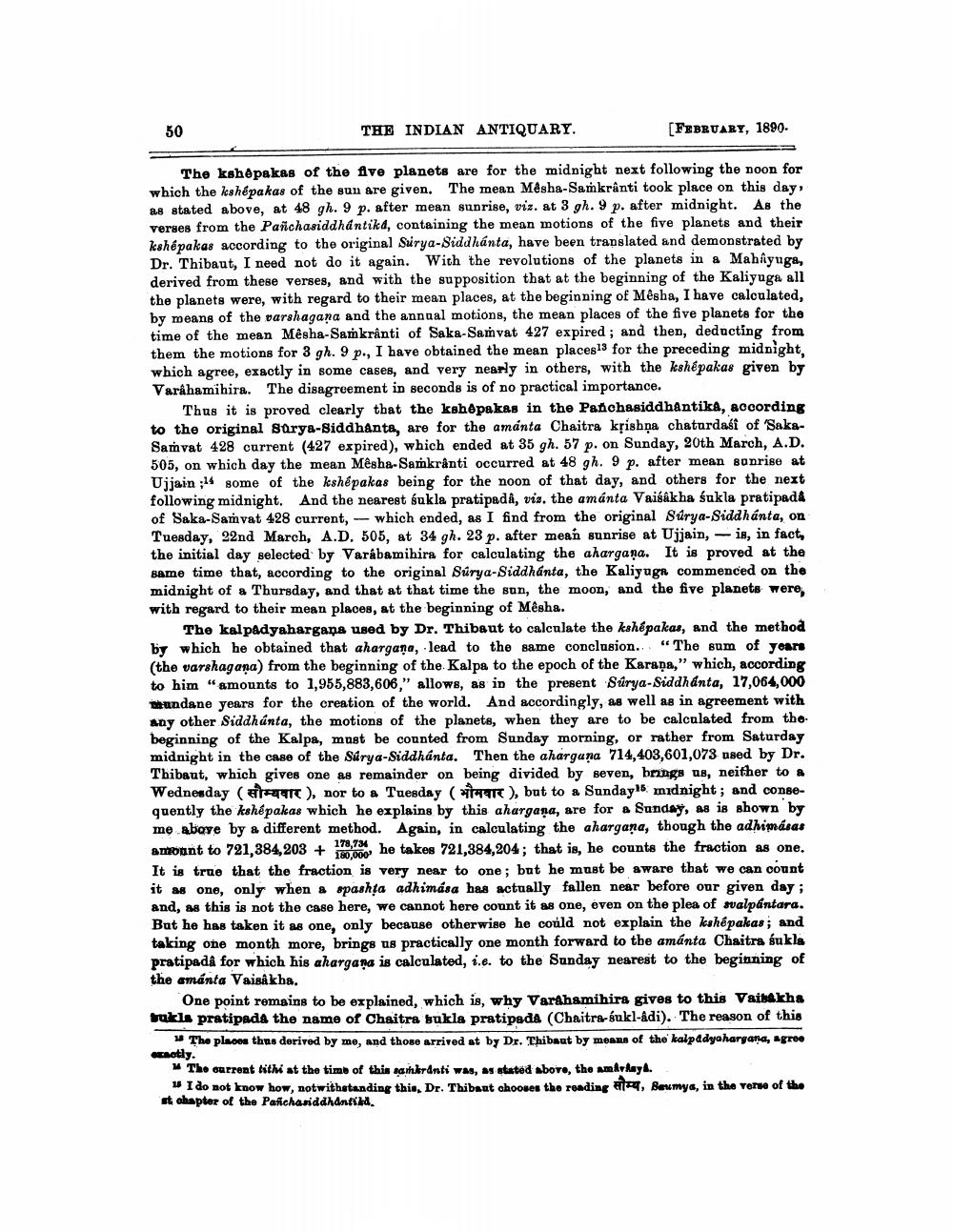________________
50
THE INDIAN ANTIQUARY.
[FEBRUARY, 1890.
The kshepakas of the five planets are for the midnight next following the noon for which the kshépakas of the sun are given. The mean Mêsha-Sankranti took place on this day, as stated above, at 48 gh. 9 p. after mean suprise, viz. at 3 gh. 9 p. after midnight. As the verses from the Panchasiddhantikd, containing the mean motions of the five planets and their kshepakas according to the original Surya-Siddhánta, have been translated and demonstrated by Dr. Thibaut, I need not do it again. With the revolutions of the planets in a Mahîyuga, derived from these verses, and with the supposition that at the beginning of the Kaliyuga all the planets were, with regard to their mean places, at the beginning of Mêsha, I have calculated, by means of the varshagana and the annual motions, the mean places of the five planets for the time of the mean Mêsha-Sankranti of Saka-Samvat 427 expired; and then, deducting from them the motions for 3 gh. 9 p., I have obtained the mean places13 for the preceding midnight, which agree, exactly in some cases, and very nearly in others, with the kshepakas given by Varkhamihira. The disagreement in seconds is of no practical importance.
Thus it is proved clearly that the kshópakas in the Panchasiddhantika, according to the original Surya-Siddhanta, are for the amánta Chaitra krishṇa chaturdasi of 'SakaSamvat 428 current (427 expired), which ended at 35 gh. 57 p. on Sunday, 20th March, A.D. 505, on which day the mean Mêsha-Sankranti occurred at 48 gh. 9 p. after mean sonrise at Ujjain 44 some of the ksh@pakas being for the noon of that day, and others for the next following midnight. And the nearest sukla pratipadi, vis, the amánta Vaisakha sukla pratipada of Saka-Samvat 428 current, which ended, as I find from the original Surya-Siddhánta, on Tuesday, 22nd March, A.D. 505, at 34 gh. 23 p. after mean sunrise at Ujjain, - is, in fact, the initial day selected by Varábamihira for calculating the ahargana. It is proved at the same time that, according to the original Súrya-Siddhanta, the Kaliyuga commenced on the midnight of a Thursday, and that at that time the sun, the moon, and the five planets were, with regard to their mean places, at the beginning of Mêsha.
The kalpadyahargana used by Dr. Thibaut to calculate the kshapakas, and the method by which he obtained that ahargana, lead to the same conclusion. "The sum of years (the varshagana) from the beginning of the Kalpa to the epoch of the Karana," which, according to him "amounts to 1,955,883,606," allows, as in the present Súrya-Siddhanta, 17,064,000 mundane years for the creation of the world. And accordingly, as well as in agreement with any other Siddhúnta, the motions of the planets, when they are to be calculated from the beginning of the Kalpa, must be counted from Sunday morning, or rather from Saturday midnight in the case of the Súrya-Siddhánta. Then the ahargana 714,403,601,073 used by Dr. Thibaut, which gives one as remainder on being divided by seven, brings us, neither to a Wednesday (Pa), nor to a Tuesday (*1947), but to a Sunday midnight; and consequently the kshépakas which he explains by this ahargana, are for a Sunday, as is shown by me above by a different method. Again, in calculating the chargana, though the adhimasas amount to 721,384,203 + 190,000, he takes 721,384,204; that is, he counts the fraction as one. It is true that the fraction is very near to one; but he must be aware that we can count it as one, only when a spashța adhimasa has actually fallen near before our given day; and, as this is not the case here, we cannot here count it as one, even on the plea of salpántara. But he has taken it as one, only because otherwise he could not explain the kshépakas; and taking one month more, brings us practically one month forward to the amánta Chaitra sukla pratipadâ for which his ahargana is calculated, i.e. to the Sunday nearest to the beginning of the amánta Vaisakha.
One point remains to be explained, which is, why Varahamihira gives to this Vaibakha takls pratipada the name of Chaitra bukla pratipada (Chaitra-sukl-Adi). The reason of this
The places thus derived by me, and those arrived at by Dr. Thibaut by means of tho kalpddycharyana, agree taotly.
The current Nithi at the time of this sankranti was, as stated above, the amkvlayl. » I do not know how, notwithstanding this, Dr. Thibaut chooses the reading 1, Beumye, in the verse of the stohapter of the Pafchasiddhantik.




